
“Black Belt Patriot” – actor turned author/pundit Chuck Norris – penned the insights on Thomas Jefferson in advance of this 4th of July holiday weekend. It is provided after the music video medley that includes a new release aimed to stir patriotic feelings by Jeffrey Steele entitled “I’m an American” as well as other provided above it. This 4th of July set of facts and musings will also include a column by Laura Hollis on Lydon Banes Johnson’s complex legacy and some closing reflections by MHProNews.
Whitney Houston – Star Spangled-Banner – Over 40 million views.
Among the annals of national anthems as a prelude to sporting events, few have topped the one delivered by Whitney Houston before Super Bowl XXV in 1991 in Tampa, Florida. A woman, her incredible voice, and the bare minimum of extraneous notes. Her rendition came at a particularly patriotic time, just after the onset of the Persian Gulf War, and was released as a single. It was re-released after the September 11th terrorist attacks. Houston donated all proceeds to charity. She ranks among the best of all-time because of the circumstances and … that voice..
Faith Hill – American Heart (Official Video)
“Audrey Faith McGraw, known professionally as Faith Hill, is an American singer, actress and record producer. She is one of the most successful country music artists of all time, having sold more than 40 million albums worldwide,” according to Wikipedia. The award winner produced this official video of her patriotic smash single, “American Heart.”
Lee Greenwood – God Bless the U.S.A. posted on July 1, 2021 and has 3,608,699 views.
Music video by Sugarland performing Everyday America – a different take that hints at the hijacking of the American Dream.
A music video of Neil Diamond’s “Coming to America” popularized by the movie, the Jazz Singer. Posted on June 12, 2006 and 4,878,743 views as of Saturday when this embed code was captured.
This is the brand-new single “I’m an American” Jeffrey Steele.
Following the music medley, next up provided by the WND NewsCenter with permission to MHProNews is the following from “Black Belt Patriot” Chuck Norris.
CULTURE WARS
4 myths about Thomas Jefferson most believe are true
Exclusive: Chuck Norris dispels untruths about 3rd president ahead of Independence Day
With July 4th approaching fast, and the fact that Thomas Jefferson is regarded as the primary author of the Declaration of Independence, I wanted to share what I learned about him from scholars of American history. Please share this info with your kids or grandkids, who, odds are, aren’t learning them.
There are four myths about Jefferson that most believe are true but are not. These are four beliefs, policies or practices often attributed to our third president that are either false or cherry-picked partial views.
The first myth is that Jefferson was for big government. Nothing could be further from the truth.
While Jefferson expanded U.S. territory through enactments like the 1803 Louisiana Purchase, he knew that when it came to expanding government, “The natural progress of things is for liberty to yield, and government to gain ground.”
Dr. Peter Unuf, professor of history at Jefferson’s own University of Virginia. explained his views well: “In Thomas Jefferson’s mind, the first order of business for him as President was the establishment of a ‘wise and frugal Government, which shall restrain men from injuring one another’ but which would otherwise leave them alone to regulate their own affairs. He wanted a government that would respect the authority of individual states, operate with a smaller bureaucracy, and cut its debts.”
Jefferson was actually for smaller government, less debt and less taxes. This quote from him is quite long, but it shares exactly what he saw would be the end outcome of a massive-spending and tax-grabbing federal government.
Jefferson wrote, “We must make our election between economy and liberty, or profusion and servitude. If we run into such debts as that we must be taxed in our meat and in our drink, in our necessaries and our comforts, in our labors and our amusements, for our callings and our creeds, as the people of England are, our people, like them, must come to labor sixteen hours in the twenty-four, give the earnings of fifteen of these to the government for their debts and daily expenses, and the sixteenth being insufficient to afford us bread, we must live, as they now do, on oatmeal and potatoes, have no time to think, no means of calling the mismanagers to account, but be glad to obtain subsistence by hiring ourselves to rivet their chains on the necks of our fellow-sufferers.”
So, did Jefferson follow his own advice? Yes, in government, but no in his personal life.
Jefferson and his contemporaries did in fact apply some wise fiscal principles to the running of the federal government. For the record, Jefferson’s administration witnessed the reduction of the national deficit during his eight-year tenure in office (1801-1809), from roughly $83,038,050.80 to $57,023,192.09, despite America’s war with the Barbary States during the same period.
Sad to say, however, that Jefferson’s own personal life ended up in quite the financial shambles, owing $107,000 when he died, which is $2 million in today’s terms.
The second myth about Thomas Jefferson is that he was always an isolationist or non-interventionist: That is, he believed the U.S. should avoid alliances with other nations so as not to draw the U.S. into wars not related to direct territorial self-defense. Neutrality was a nice goal of our first presidents, but rarely enacted in reality.
True, President Jefferson is often noted as extending George Washington’s ideas of commercial-only relations with other countries. For example, in his March 4, 1801inaugural address, he said, “peace, commerce, and honest friendship with all nations, entangling alliances with none.”
But a brief view of virtually any country’s history – including the U.S. and Jeffersonian actions in government – easily demonstrates that commercial-only relations more often than not morph into “entangling alliances.”
Case in point: France. Our founders were largely non-interventionists, at least in desire and theory. But when push came to shove, our founders signed the Treaty of Alliance with France on Feb. 6, 1778, creating a military alliance between the U.S. and France against Great Britain. The U.S. also signed the Treaty of Amity and Commerce with France on the same day, endorsing trade and commerce between the two countries.
And if one thinks that those treaties were signed only to secure freedom and stability in the Revolutionary era, consider that they weren’t annulled by Congress until 25 years later in 1798. If 25 years doesn’t qualify as an “entangled alliance,” then what does?
Jefferson’s own enablement of an entangled alliance with France seems to be further supported by the fact that he was one of America’s greatest Francophiles and lived some of the best years of his life in Paris, from August 1784 to September 1789, bringing back dozens of crates from the European culture to his own Monticello estate.
And on another battlefront, let’s also not forget that Jefferson confessed to Congress in 1801 that he was “unauthorized by the Constitution, without the sanction of Congress, to go beyond the line of defense,” when he ordered a small fleet of warships to the Mediterranean to ward off attacks by the Barbary Powers. Marines and warships were deployed to the region, which eventually led to the surrender of Tripoli in 1805. Nevertheless, it would still take another decade to defeat completely those sea-marauding pirates.
The third myth is that Jefferson was pro-abortion, which many liberals and progressives espouse he was. Again, nothing could be further from the truth.
Thomas Jefferson and Alexander Hamilton both made comments about the ‘concealment laws’ in their states that demonstrated how they approved of a murder charge for a woman who intentionally aborted her child. The “concealment laws” were adopted by most states, and prohibited infanticide and even abortion, especially “post-quickening.”
Jefferson firmly believed it is the primary purpose of government to protect every human’s rights for life, liberty and the pursuit of happiness from the womb to the tomb. As he wrote after eight years as president, in 1809, “The care of human life and happiness, and not their destruction, is the first and only legitimate object of good government.”
That is why Jefferson wrote in the Declaration of Independence: “We hold these truths to be self-evident, that all men are created equal, that they are endowed by their Creator with certain unalienable Rights, that among these are Life, Liberty and the pursuit of Happiness. – That to secure these rights, Governments are instituted among men, deriving their just powers from the consent of the governed.”
The fourth and last myth concerning Thomas Jefferson was that his view of the First Amendment (and particularly its’ Separation Clause) prohibited any intermingling between church and state. Again, nothing could be further from the truth.
As I wrote in “Black Belt Patriotism,” skeptics are quick to point to Thomas Jefferson, who is generally hailed as the chief of church-state separation. But proof that Jefferson was not trying to rid government of religious (specifically Christian) influence comes from the fact that he endorsed using government buildings for church meetings, signed a treaty with the Kaskaskia Indians that allotted federal money to support the building of a Catholic church and to pay the salary of the church’s priests, and repeatedly renewed legislation that gave land to the United Brethren to help their missionary activities among the Indians.
Some might be completely surprised to discover that just two days after Jefferson wrote his famous letter citing the “wall of separation between Church and State,” he attended church in the place where he always had as president: the U.S. Capitol. The very seat of our nation’s government was used for sacred purposes. As the Library of Congress website notes, “It is no exaggeration to say that on Sundays in Washington during the administrations of Thomas Jefferson (1801–1809) and of James Madison (1809–1817) the state became the church.”
Please re-read those five words: “… the state became the church”! What’s not clear about that?
One of the most brilliant scholars in the modern age on religion in America is Dr. Michael Novak, a former university professor and U.S. ambassador, who was awarded the $1 million Templeton Prize for Progress in Religion and served as Jewett Chair in Religion and Public Policy at the American Enterprise Institute.
Dr. Novak said the following about the last 100 years of religious education in our secular academia and institutions across America: “This is a scandal. How could it have happened? For one thing, many of the guardians of the nation’s memory are secular men, for whom the faith of our fathers is of diminishing importance. The law schools, the jurists, and the history departments show little interest in religion. One wing [i.e. faith and religion] of the eagle by which American democracy took flight has been quietly forgotten. … In one key respect, the way the story of the United States has been told for the past one hundred years is wrong.”
That is why I say, the best thing you can do this forthcoming Fourth of July week is teach your family and friends about America’s true history. Maybe you can start by sharing this column.
Happy upcoming Independence Day! And God bless America!
(For those interested in understanding the truth about history and what George Washington called “the pillar and foundation of our republic, which no true patriot can subvert,” that is, religion, please purchase and read Dr. Michael Novak’s “On Two Wings: Humble Faith and Common Sense at the American Founding.”) ##
The final third-party provided item before a few reflections from MHProNews is this by Laura Hollis via the WND NewsCenter. While this isn’t ‘patriotic’ or about the 4th in the strict sense, it does provide an important and useful backdrop to the Lyndon Banes Johnson era expansion of the federal government. Its projections vs. actual outcomes is going to surprise some.
COMMENTARY
The failed legacy of Johnson’s ‘Great Society’
Laura Hollis spells out the massive, continuing consequences
By Laura Hollis Published June 23, 2022 at 8:48pm
When I was in Austin, Texas, last week, I took the opportunity to visit the Lyndon Baines Johnson Presidential Library on the University of Texas campus. The library is housed in a beautiful building with impressive resources. Its employees and volunteers are gracious and welcoming. I thoroughly enjoyed the exhibits (especially those devoted to the contributions of LBJ’s lovely and accomplished wife, Lady Bird Johnson).
And yet, I came away from my visit profoundly sad.
LBJ’s legacy is a complicated one. As John F. Kennedy’s vice president, Johnson was thrust into the presidency by Kennedy’s assassination in Dallas on Nov. 22, 1963. President Johnson’s speech to the nation just five days later is considered one of the finest of his career. (He began with the somber words, “All I have, I would have given gladly not to be standing here today.”) Even so, Johnson viewed Kennedy’s death as an opportunity for self-aggrandizement and to push his own agenda. “I am a Roosevelt New Dealer,” Johnson said the day after the assassination. “Kennedy was a little too conservative to suit my taste.”
Johnson was a vehement and vocal racist, yet considered a civil rights hero for passage of the Civil Rights Act of 1964 and a barrage of other legislation advancing social programs as part of his Great Society policy initiatives, modeled after the New Deal of Depression-era President Franklin D. Roosevelt.
But if history has (for the most part) been kind to FDR, the same cannot be said of LBJ.
The mistakes and failures of the Great Society programs continue to rack up. Health care policy analyst Sally Pipes provided sobering statistics in an article for Forbes magazine last year. Two years after Medicare was launched in 1965, the House Ways and Means Committee forecast that Medicare spending would be $12 billion by 1990; the actual figure was $110 billion. Last year, Medicare spending was $875 billion, with approximately 62 million people enrolled. That number is expected to be nearly 80 million by 2030, at which point Medicare spending will be well over $1 trillion.
Medicaid has had a similar trajectory. It cost taxpayers $3 billion in 1967, when slightly less than 4% of the U.S. population was enrolled. As of February 2022, 87 million people were receiving Medicaid or CHIP (Children’s Health Insurance Program) benefits – 26% of the population, or more than one in every four Americans. Medicaid spending in 2021 was $696 billion. Of that, $86 billion (that we know of) was squandered on fraud or other “improper payments.”
Regrettably, these programs have failed to achieve their stated objectives. The Heritage Foundation published a report on the 50th anniversary of Johnson’s “Great Society” speech. Data shows that poverty rates dropped dramatically between the end of World War II and 1964. And yet, despite expenditures of more than $22 trillion since 1964, the poverty rate has consistently remained between 12% and 15%.
The data on health outcomes is not much more encouraging.
One of the most distressing aspects of the COVID-19 pandemic was its disproportionate impact on obese people, who were, according to a 2020 study published in Obesity Reviews, “113% more likely than people of healthy weight to land in the hospital, 74% more likely to be admitted to an ICU, and 48% more likely to die.” But even before COVID, obesity’s toll on Americans’ health was staggering; the Centers for Disease Control and Prevention reports that health care costs associated with obesity-related illness are more than $170 billion a year and rising.
The hundreds of billions being spent annually on Medicare and Medicaid have not made a dent. Quite the contrary. The percentage of obese adults in the early 1960s, prior to the passage of Johnson’s Great Society programs, was just 13%. Among children, it was only 5%. Today, 42% of American adults are obese (up from 30.5% as recently as 1999). And according to the journal Global Pediatric Health, obesity has doubled in children and tripled in adolescents since 1990. Furthermore, there is a strong (and unusual) correlation between poverty and obesity in the U.S. An article published in 2011 in the journal of the American Diabetes Association states, “In contrast to international trends, people in America who live in the most poverty-dense counties are those most prone to obesity.”
The welfare state created by Johnson’s Great Society programs has had an outsized negative effect on America’s black population as well. Black economist and bestselling author Thomas Sowell has written about this extensively. In 2014, Sowell responded to New York Times’ writer Nicholas Kristof, who attributed the economic struggles of U.S. blacks to the legacy of racism.
Sowell, who grew up in poverty, disagrees. In his column, “A legacy of liberalism,” he wrote:
Despite the grand myth that black economic progress began or accelerated with the passage of the civil rights laws and ‘war on poverty’ programs of the 1960s, the cold fact is that the poverty rate among blacks fell from 87 percent in 1940 to 47 percent by 1960. This was before any of those programs began. … Nearly a hundred years of the supposed ‘legacy of slavery’ found most black children being raised in two-parent families in 1960. But thirty years after the liberal welfare state found the great majority of black children being raised by a single parent. … The murder rate among blacks in 1960 was one-half of what it became 20 years later, after a legacy of liberals’ law enforcement policies.
As one might expect, the exhibits at the LBJ Presidential Library focus more on the magnitude of the challenges Johnson faced and his deep humanitarian intentions than on the consequences of his Great Society initiatives. But Americans must evaluate the results – and costs – of political programs with eyes unclouded by sentiment or nostalgia.
We continue to suffer the consequences of the misguided policies of the 1960s. Johnson may have had ignorance as an excuse. Almost 60 years later, we do not. ##
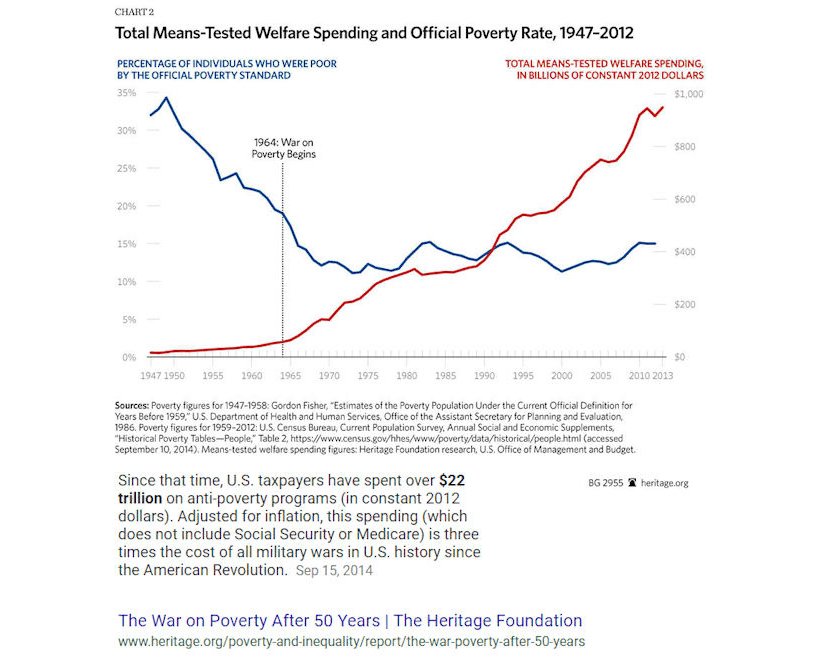
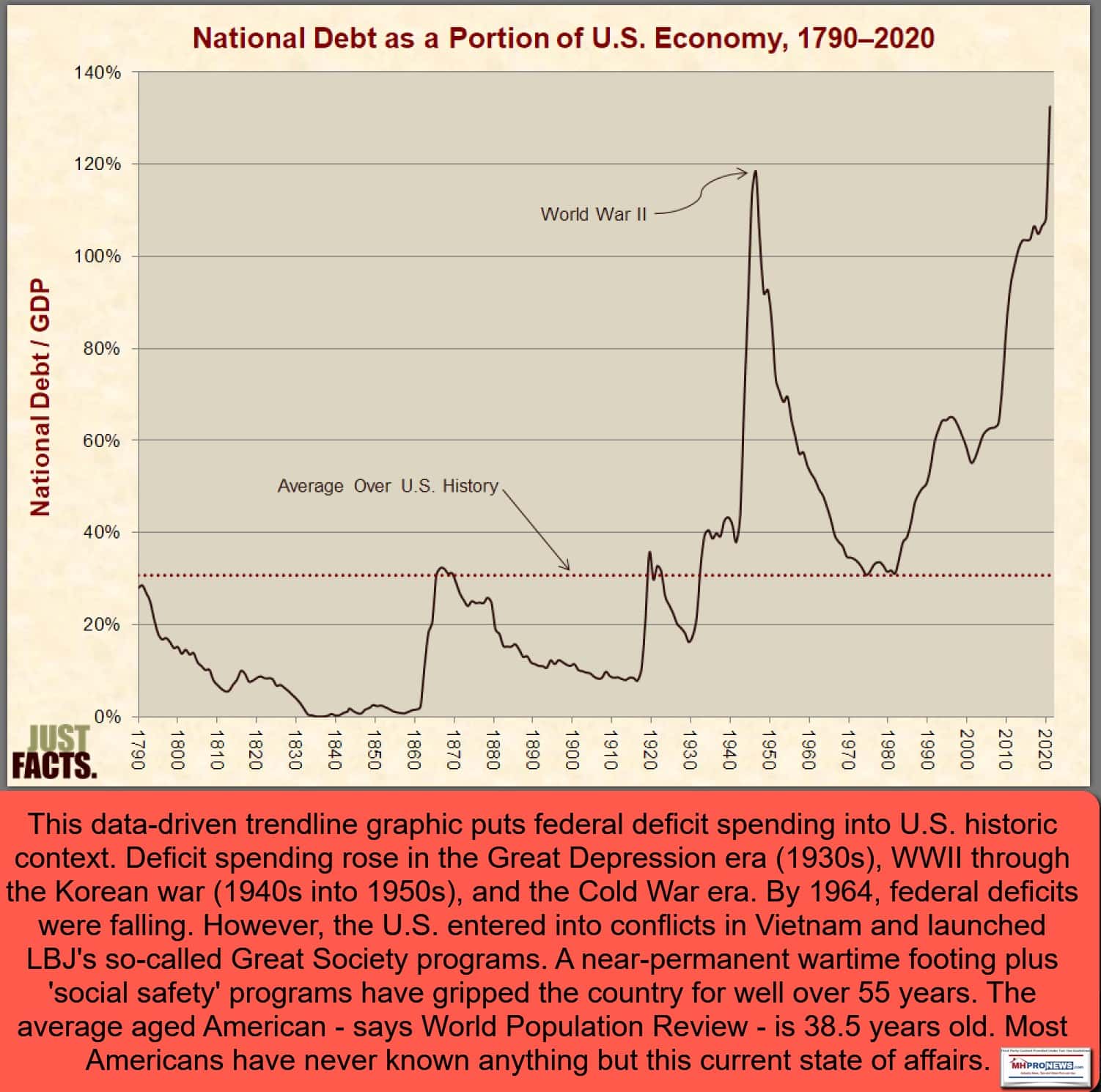
Note: the graphics below have been provided previously by MHProNews and illustrate some of the points raised by Hollis’ thoughtful column. Certainly one takeaway is that big government has failed to deliver on its ambitious promises.

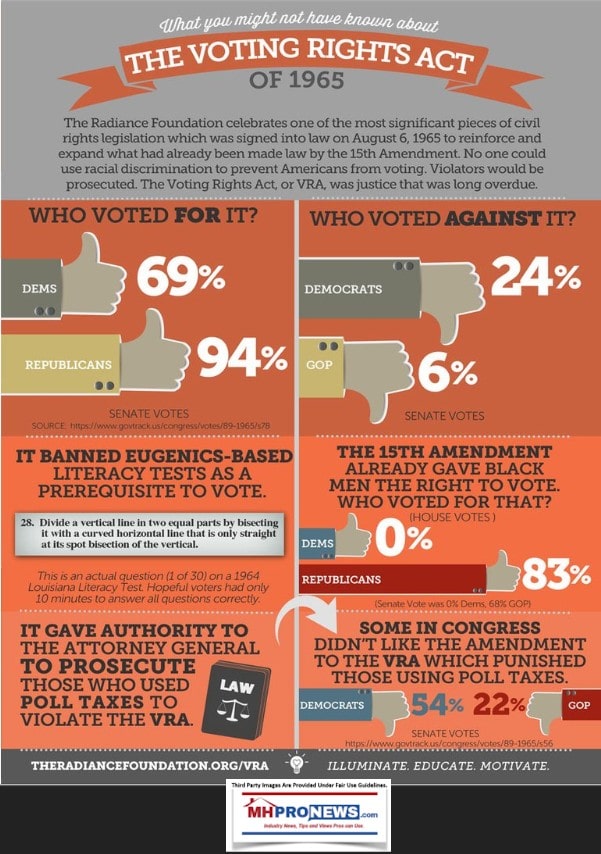
Additional Information, More MHProNews Analysis and Commentary
Freedom is never free. Freedom isn’t passed on through the generations without effort. The greatest threats to freedom in the U.S. have historically been internal, not external. Those points are made by the famous quotes that follow.



But the threat to American freedom has arguably been a slow, long march to change the fundamental nature of America from one of limited government and maximum freedom to one of big government which routinely means a loss of freedom. This Fourth, the need to better understand and return to the basics that made America the envy of the world should be examined, better understood, and embraced. The opposite being sold by fascist corporate interests that posture being ‘woke’ and leftist policies should be rejected. Freedom isn’t free. Big ‘all powerful’ government and personal liberty are at odds. Big government results in cronyism and corruption. For evidence, see the linked reports. ###

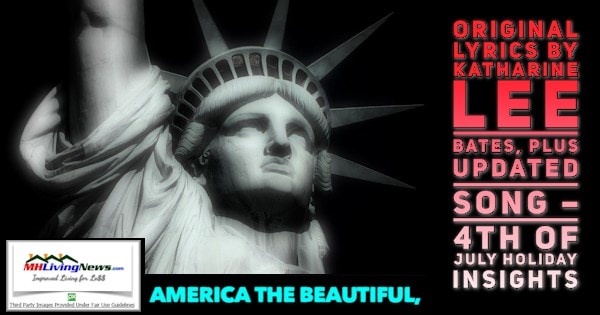
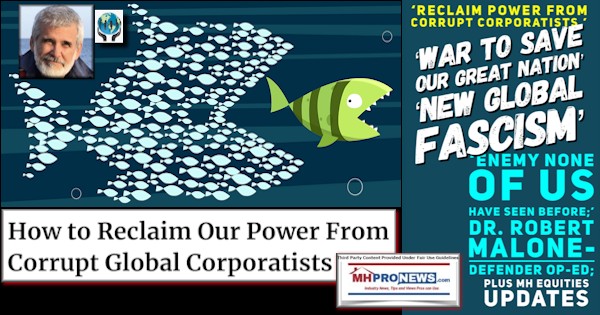

Again, our thanks to free email subscribers and readers you, our tipsters/sources, and sponsors and God for making and keeping us the runaway number one source for authentic “News through the lens of manufactured homes and factory-built housing” © where “We Provide, You Decide.” © ## (Affordable housing, manufactured homes, reports, fact-checks, analysis, and commentary. Third-party images or content are provided under fair use guidelines for media.) (See Related Reports, further below. Text/image boxes often are hot-linked to other reports that can be access by clicking on them.)

By L.A. “Tony” Kovach – for MHProNews.com.
Tony earned a journalism scholarship and earned numerous awards in history and in manufactured housing.
For example, he earned the prestigious Lottinville Award in history from the University of Oklahoma, where he studied history and business management. He’s a managing member and co-founder of LifeStyle Factory Homes, LLC, the parent company to MHProNews, and MHLivingNews.com.
This article reflects the LLC’s and/or the writer’s position, and may or may not reflect the views of sponsors or supporters.
Connect on LinkedIn: http://www.linkedin.com/in/latonykovach
Related References:
The text/image boxes below are linked to other reports, which can be accessed by clicking on them.

























